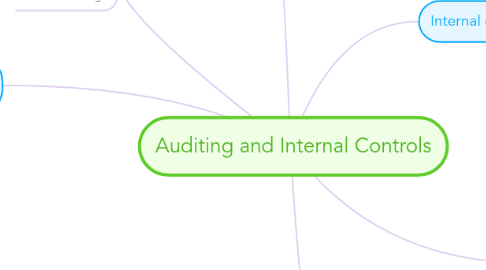
1. Audit committees
1.1. Appointment
1.2. Duties
2. Auditing (Fields)
2.1. Internal controls
2.2. Internal Auditing
2.3. External Auditing
3. Internal Auditing (audit done Quarterly)
3.1. INTERNAL AUDITOR
3.1.1. Policies, plans, procedures, laws and regulations are adhered to
3.1.2. Information is reliable
3.1.3. All assets are accounted for
3.1.4. Resources are being used economically and efficiently
3.1.5. Objectives are accomplished
3.1.5.1. AFTER ABOVE TASKS ARE ACCOMPLISHED: Auditor will then give a written report on findings and recommendations then given to top management (Audit Committee)
3.2. Accounting control measures
3.2.1. Purpose of these measures is to safeguard assets and to ensure that accurate and reliable reporting of financial data occurs.
3.3. Audit Trial
3.3.1. Audit evidence
3.3.1.1. Observation of procedure
3.3.1.2. Checking calculations
3.3.1.3. Creditor's statements
3.3.1.4. Evidence from ratio analysis
3.3.2. Gather evidence
3.3.2.1. Looking at and testing control systems
3.3.2.2. Watching how employees perform procedures
3.3.2.3. Ask employees for information or amounts and check whether they are correct
3.3.2.4. Track, trace and recalculate the amounts and trace or re-perform the process where the amounts originated
3.3.3. Important for auditor to consider
3.3.3.1. Accuracy of recording onto source documents
3.3.3.2. Authorisation on source documents
3.3.3.3. Accuracy of the recording of the transaction in accounting records (journals, ledgers, financial statements)
3.3.4. Accounting cycle
3.3.4.1. Auditor checks whether the transaction that took place was recorded correctly on source document and has gone through the accounting cycle correctly until the financial statements.
3.3.5. Audit Sampling (statistical sampling)
3.3.5.1. Check transactions based on amounts
3.3.5.2. Check randomly
3.3.5.3. Check every 10th transaction
3.3.5.4. 10%-20% of transactions should be sampled
3.3.6. How do we know whether evidence is sufficient?
3.3.6.1. Professional judgement
3.3.6.1.1. If error found in certain aspect, you should test more, if no error found, you decide not to test further
3.3.6.2. Risk
3.3.6.2.1. After testing 30 entries, no errors - system: Low risk
3.3.6.2.2. Error found between 21 - 30 entries - system: Medium risk
3.3.6.2.3. Error found testing less than 20 entries - system: High risk
3.3.7. Preparing audit report
3.3.7.1. Whether the internal controls are correct and reliable
3.3.7.2. Whether employees and management are working according to the systems in place
3.3.7.3. Done independently which adds credibility and transparancy
3.3.7.4. 4 topics covered in report: Description of processes used (audit sampling), findings and conclusions, who should be held accountable, recommendations for improvement to internal control processes.
3.3.8. Interpreting the Audit report
3.3.8.1. Helps management to identify areas of control that are working and what areas need improvement
4. Annual Financial Reports
4.1. Statement of income (Income Statement)
4.2. Statement of financial position (Balance sheet)
4.3. Statement of cash flows (Cash Flow statement)
4.4. Sustainability Report
4.5. Director's Report
4.6. Auditor's Report
5. External Auditor
5.1. External Auditors report
5.1.1. Why independent auditors? So that shareholders know that their opinion is not biased
5.2. Opinion / Report consists of
5.2.1. Pages of Financial statements covered by the audit
5.2.2. Scope of auditors responsibilities
5.2.3. What the audit involved
5.2.4. Opinion - Qualified (errors of concern found) or unqualified (no errors of concern found)
6. Internal control measures
6.1. Purpose
6.2. Objectives
6.3. Types
6.4. Systems
6.4.1. Accounting controls
6.4.2. Control Systems
6.4.2.1. Cash
6.4.2.2. Stock
6.4.2.3. Fixed Assets
6.4.2.4. Debtors

